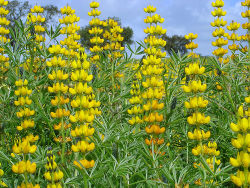Lupinus luteus
| Lupinus luteus subsp. var. | ||||||||||||||||||||||||||||||||||||||||||||||||||||||||
|---|---|---|---|---|---|---|---|---|---|---|---|---|---|---|---|---|---|---|---|---|---|---|---|---|---|---|---|---|---|---|---|---|---|---|---|---|---|---|---|---|---|---|---|---|---|---|---|---|---|---|---|---|---|---|---|---|

|
|
| ||||||||||||||||||||||||||||||||||||||||||||||||||||||
| ||||||||||||||||||||||||||||||||||||||||||||||||||||||||
| Standard Cyclopedia of Horticulture |
|---|
|
Lupinus luteus, Linn. Yellow Lupine. Fig. 2218. St. erect, nearly simple, hairy, 2 ft. high: 1fts. lanceolate, acute, hairy: fls. on pubescent stalks longer than the lvs., verticillate, yellow, fragrant: pod oblong, flat. June, July. S. Eu. B.M. 140.—Succeeds in the poorest soil. Useful for cut-fls., for the border, for fodder or for plowing under to improve sandy soils. As a fodder, it may be fed green or as hay.
|
Lupinus luteus L. 1753, Sp. Pl. :722; Willd. 1803, l. c.:1024; DC. 1825, l.c.:407; Willk. et Lange, 1880, l. c.:468; Franco et Silva, 1968, l. c.:105; Zohary, 1972, l. c.:44; Gladstones, 1974, l. c.:17; Vass. 1987, l. c.:214. – yellow lupin.
| Lupinus luteus L. - Yellow lupin {{{status}}} Fossil range: {{{fossil_range}}}
| ||||||||||||||||||||||||||||||||||||||||||||||||||||||||||||||||||
|---|---|---|---|---|---|---|---|---|---|---|---|---|---|---|---|---|---|---|---|---|---|---|---|---|---|---|---|---|---|---|---|---|---|---|---|---|---|---|---|---|---|---|---|---|---|---|---|---|---|---|---|---|---|---|---|---|---|---|---|---|---|---|---|---|---|---|
 | ||||||||||||||||||||||||||||||||||||||||||||||||||||||||||||||||||
| Plant Info | ||||||||||||||||||||||||||||||||||||||||||||||||||||||||||||||||||
| ||||||||||||||||||||||||||||||||||||||||||||||||||||||||||||||||||
| Scientific classification | ||||||||||||||||||||||||||||||||||||||||||||||||||||||||||||||||||
| ||||||||||||||||||||||||||||||||||||||||||||||||||||||||||||||||||
| [[{{{diversity_link}}}|Diversity]] | ||||||||||||||||||||||||||||||||||||||||||||||||||||||||||||||||||
| {{{diversity}}} | ||||||||||||||||||||||||||||||||||||||||||||||||||||||||||||||||||
| Binomial name | ||||||||||||||||||||||||||||||||||||||||||||||||||||||||||||||||||
| {{{binomial}}} | ||||||||||||||||||||||||||||||||||||||||||||||||||||||||||||||||||
| Trinomial name | ||||||||||||||||||||||||||||||||||||||||||||||||||||||||||||||||||
| {{{trinomial}}} | ||||||||||||||||||||||||||||||||||||||||||||||||||||||||||||||||||
| Type Species | ||||||||||||||||||||||||||||||||||||||||||||||||||||||||||||||||||
| {{{type_species}}} | ||||||||||||||||||||||||||||||||||||||||||||||||||||||||||||||||||
| {{{subdivision_ranks}}} | ||||||||||||||||||||||||||||||||||||||||||||||||||||||||||||||||||
| [[Image:{{{range_map}}}|{{{range_map_width}}}|]] | ||||||||||||||||||||||||||||||||||||||||||||||||||||||||||||||||||
| Synonyms | ||||||||||||||||||||||||||||||||||||||||||||||||||||||||||||||||||
| {{{synonyms}}} |
Description
Distribution and common names: W Iberia, scattered pan-Mediterranean, native or semi-cult.; elsewhere, cult.
"Yellow lupin".
Plants are 20-80 cm high, rosetted in the beginning and becoming erect in subsequent, with vigorous basal branching. Stems are short and hirsute, with intesive branching in the lower part. The leaf consists of 7-9 (11) ovate-oblong or lanceolate leaflets, prolated at the basis, densely villous on both sides, sized 30-60 х 8-15 mm. Stipules of the rosetted leaves are crescent and chuffy on stalks, linear-obovate in shape. The inflorescence is an elongated truss, 5-25 cm long, set on a peduncle of 5-12 cm. Flowers are verticillate, odorous. Floral bracts are small-sized, obovate, silky-pubescent, easily falling. The upper labium of a calyx is bipartite, the lower one has 3 small denticles. The corolla is 14-16 mm long, bright goldish-yellow in color. Pods are elongated, 40-60 х 10-14 mm, densely villous, 4-6-seeded, with oblique partitions between seeds. Seeds are 5,5-6,5 mm in diameter, spherical-reniform, oblate, variable colouring - from pinkish, brown and yellowish up to dark-violet and mottled.
Usually this species is considered as an annual one, but in wild environments it is sometimes possible to find two- and four-year plants. The variability of characters in this species is less expressed than in L.angustifolius; however a homologous series can be modeled on the color of seeds, which is more or less similar to L. angustifolius. 2n=52 .
The scheme of classification of Lupinus luteus L.
Using combinations of such characters as the color of the corolla, the carina's edge, vegetative organs and seeds, 18 varieties, 4 subvarieties and 6 forms have been identified.
References:
1.Intraspecific Diversity of Lupins
2.Kurlovich B.S. 2002. Lupins. Geography, classification, genetic resources and breeding , St. Petersburg, “Intan”, 468p. http://koti.mbnet.fi/bkurl/Lupin.htm
3. Gladstones, J.S. 1998. Distribution, Origin, Taxonomy, History and Importance. In: J.S. Gladstones et al. (eds.), Lupin as Crop Plants. Biology, Production and Utilization, 1-39.